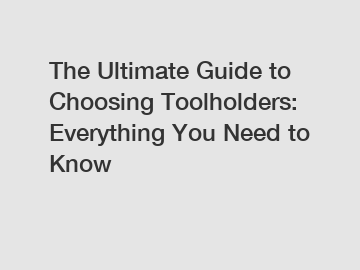The Ultimate Guide to Choosing Toolholders: Everything You Need to Know
The Ultimate Guide to Choosing Toolholders: Everything You Need to Know.
When it comes to machining processes, choosing the right toolholder is a critical decision that can significantly impact the success of your operations. Toolholders play a crucial role in securely holding cutting tools, ensuring their stability and precision during operation. In this comprehensive guide, we will walk you through everything you need to know about choosing toolholders, from their different types to the factors you should consider when making a selection.
Firstly, let's delve into the different types of toolholders available in the market. There are several common types, including collet chucks, end mill holders, and shell mill holders. Each type offers unique advantages and is suitable for specific applications. Collet chucks, for instance, are highly versatile and excel in gripping small diameter tools with exceptional precision. On the other hand, end mill holders are designed for holding end mills securely and are ideal for milling applications. Shell mill holders, as the name suggests, are used for holding shell mills and are known for their stability and rigidity.

The selection process for toolholders involves considering various factors, such as the type of machining operation, the material being cut, and the machine tool being used. For instance, if you are performing heavy-duty machining, you would require a toolholder with high gripping force and rigidity to withstand the forces involved. In contrast, when machining delicate materials, a toolholder with vibration damping capabilities may be preferred to ensure precision and surface finish quality.
It is crucial to also consider the compatibility between the toolholder and the cutting tool being used. The toolholder should have a precise fit with the cutting tool to prevent any slippage or movement during operation. Additionally, factors such as tool runout, balancing requirements, and tool length should be taken into account to ensure optimal performance and tool life.
The selection of the right toolholder has significant implications for machining efficiency, tool life, and overall productivity. A well-chosen toolholder can enhance tool rigidity, reduce vibration, and improve cutting performance. This, in turn, leads to extended tool life, reduced downtime for tool changes, and improved surface finish quality. On the other hand, selecting an incompatible or inadequate toolholder can result in poor tool life, reduced machining accuracy, and increased chances of tool breakage.
In conclusion, choosing the right toolholder is vital for successful machining operations. By considering factors such as the type of machining operation, material being cut, and compatibility with the cutting tool, you can ensure optimal performance, tool life, and productivity. Investing time and effort in selecting the appropriate toolholder will yield significant benefits in terms of machining efficiency and quality. So, make an informed decision, and let your toolholder be the key to unlocking exceptional machining performance.
If you are looking for more details, kindly visit BT30 ER40, Morse Taper Face Mill Arbor, CNC toolholder price.

Comments
0